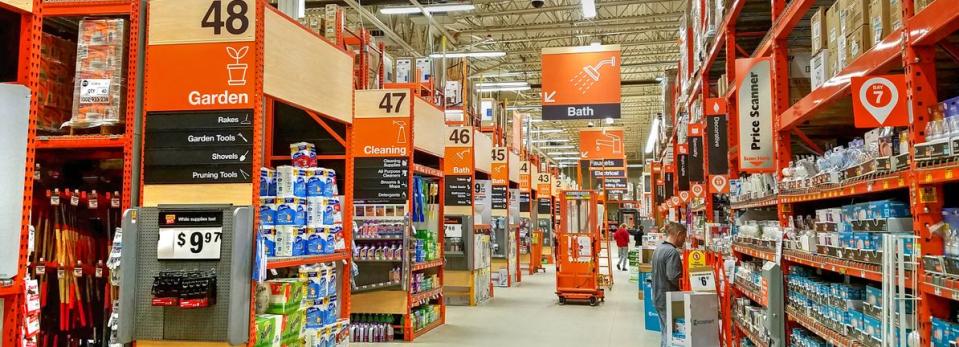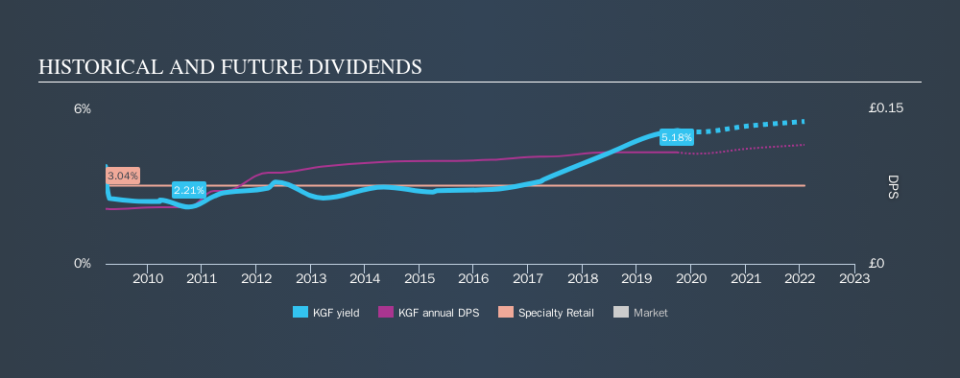Don't Buy Kingfisher plc (LON:KGF) For Its Next Dividend Without Doing These Checks

Kingfisher plc (LON:KGF) is about to trade ex-dividend in the next 3 days. You can purchase shares before the 3rd of October in order to receive the dividend, which the company will pay on the 8th of November.
Kingfisher's upcoming dividend is UK£0.03 a share, following on from the last 12 months, when the company distributed a total of UK£0.1 per share to shareholders. Calculating the last year's worth of payments shows that Kingfisher has a trailing yield of 5.2% on the current share price of £2.089. We love seeing companies pay a dividend, but it's also important to be sure that laying the golden eggs isn't going to kill our golden goose! We need to see whether the dividend is covered by earnings and if it's growing.
View our latest analysis for Kingfisher
Dividends are typically paid out of company income, so if a company pays out more than it earned, its dividend is usually at a higher risk of being cut. Kingfisher distributed an unsustainably high 125% of its profit as dividends to shareholders last year. Without extenuating circumstances, we'd consider the dividend at risk of a cut. Yet cash flows are even more important than profits for assessing a dividend, so we need to see if the company generated enough cash to pay its distribution. It paid out 91% of its free cash flow in the form of dividends last year, which is outside the comfort zone for most businesses. Companies usually need cash more than they need earnings - expenses don't pay themselves - so it's not great to see it paying out so much of its cash flow.
As Kingfisher's dividend was not well covered by either earnings or cash flow, we would be concerned that this dividend could be at risk over the long term.
Click here to see the company's payout ratio, plus analyst estimates of its future dividends.
Have Earnings And Dividends Been Growing?
When earnings decline, dividend companies become much harder to analyse and own safely. If earnings decline and the company is forced to cut its dividend, investors could watch the value of their investment go up in smoke. Kingfisher's earnings per share have fallen at approximately 22% a year over the previous five years. Such a sharp decline casts doubt on the future sustainability of the dividend.
Many investors will assess a company's dividend performance by evaluating how much the dividend payments have changed over time. Kingfisher has delivered 7.3% dividend growth per year on average over the past ten years. That's intriguing, but the combination of growing dividends despite declining earnings can typically only be achieved by paying out a larger percentage of profits. Kingfisher is already paying out 125% of its profits, and with shrinking earnings we think it's unlikely that this dividend will grow quickly in the future.
To Sum It Up
Should investors buy Kingfisher for the upcoming dividend? Not only are earnings per share declining, but Kingfisher is paying out an uncomfortably high percentage of both its earnings and cashflow to shareholders as dividends. This is a clearly suboptimal combination that usually suggests the dividend is at risk of being cut. If not now, then perhaps in the future. Overall it doesn't look like the most suitable dividend stock for a long-term buy and hold investor.
Curious what other investors think of Kingfisher? See what analysts are forecasting, with this visualisation of its historical and future estimated earnings and cash flow.
A common investment mistake is buying the first interesting stock you see. Here you can find a list of promising dividend stocks with a greater than 2% yield and an upcoming dividend.
We aim to bring you long-term focused research analysis driven by fundamental data. Note that our analysis may not factor in the latest price-sensitive company announcements or qualitative material.
If you spot an error that warrants correction, please contact the editor at editorial-team@simplywallst.com. This article by Simply Wall St is general in nature. It does not constitute a recommendation to buy or sell any stock, and does not take account of your objectives, or your financial situation. Simply Wall St has no position in the stocks mentioned. Thank you for reading.

 Yahoo Finance
Yahoo Finance 
